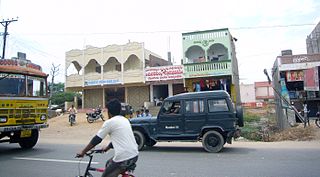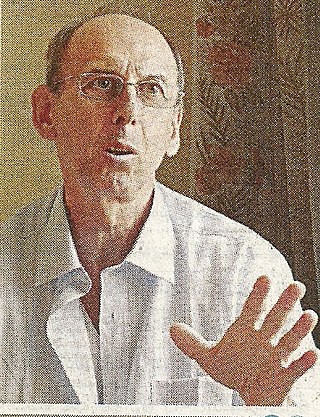
Andhra Pradesh is a state in the southern coastal region of India. It is the seventh-largest state with an area of 162,970 km2 (62,920 sq mi) and the tenth-most populous state with 49,577,103 inhabitants. It has shared borders with Chhattisgarh, Odisha, Karnataka, Tamil Nadu, Telangana and the Bay of Bengal. It has the second-longest coastline in India at about 974 km (605 mi). After existence as Andhra State and unified Andhra Pradesh, the state took its present form on 2 June 2014, when the new state of Telangana was formed through bifurcation. Amaravati is the capital of the state, with the largest city being Visakhapatnam. Water sharing disputes and asset division with Telangana are not yet resolved. Telugu, one of the classical languages of India used by the majority of people, is the first official language.

Telangana is a landlocked state in India situated on the south-central stretch of the Indian peninsula on the high Deccan Plateau. It is the eleventh-largest state and the twelfth-most populated state in India as per 2011 census. On 2 June 2014, the area was separated from the northwestern part of Andhra Pradesh as the newly formed state of Telangana, with Hyderabad as its capital.

Kattangoor is a village in Nalgonda district of state of Telangana, India. It is located in Kattangur, mandal of the Nalgonda division.

Oggu Katha or Oggukatha is a traditional folklore singing, praising and narrating the stories of Hindu gods Mallana, Beerappa and Yellamma. It originated among the Kuruma (Kuruba)and Yadava communities, who devoted themselves to the singing of ballads in praise of Lord Shiva. These tradition-loving and ritual-performing community moves from place to place, narrating the stories of their caste gods. Oggus are the traditional priests of the Yadavas and perform the marriage of Mallanna with Bhramaramba.

The Jangam or Jangamaru are a Shaiva order of religious monks. They are the priests (Gurus) of the Hindu Shaiva sect, Gurus of Veerashaiva sect and are disciples of Lord Shiva as mentioned in Basava Puranas. The meaning of word Jangam is 'moving linga'. Jangama is one who is endowed with true spirit of Agamic knowledge, and has sacrificed his life for giving Samskara (good) character building practices in all sections of the Hindu society.
The dance forms of Andhra Pradesh take on a wide variety of colors, costumes, and types; and involve different settings and musical instruments.

The Satyanarayana Puja is a puja dedicated to the Hindu god Vishnu, who is also known as Satyanarayana.

Harikatha, also known as Harikatha Kaalakshepam in Telugu and Tamil, is a form of Hindu traditional discourse in which the storyteller explores a traditional theme, usually the life of a saint or a story from an Indian epic. The person telling the story through songs, music and narration is called a Haridasa.

Telugu theatre is Indian theatre in the Telugu language, based in the states of Andhra Pradesh and Telangana. Gurajada Apparao wrote the play, Kanyasulkam in 1892, which is often considered the greatest play in the Telugu language. C. Pullaiah is cited as the father of Telugu theatre movement.
Katha is an Indian style of religious storytelling, performances of which are a ritual event in Hinduism. In Sikhism, the term refers to religious discourses focused on educating the congregation on the proper meaning of the teachings set-out in the Sikh scriptures and other texts to guide correct beliefs and practices. It often involves priest-narrators who recite stories from Hindu religious texts, such as the Puranas, the Ramayana or Bhagavata Purana, followed by a commentary (Pravachan). Kathas sometimes take place in households, involving smaller stories related to the Vrat Katha genre. The didactic Satyanarayan and Ramayana kathas instill moral values by revealing the consequences of human action (karma).

Ravindra Bharathi is an auditorium located in Hyderabad, Telangana, India. It was named after Rabindranath Tagore.

The culture of Andhra Pradesh embodies some very exclusive and special entities.
Nataraja Ramakrishna was an Indian dance guru. He was the chairman of Andhra Pradesh Sangeeta Nataka Academy. He was also a scholar and musicologist who promoted classical dance in Andhra Pradesh and worldwide.

Viswanatha Satyanarayana was a 20th-century Telugu writer. His works included poetry, novels, dramatic play, short stories and speeches, covering a wide range of subjects such as analysis of history, philosophy, religion, sociology, political science, linguistics, psychology and consciousness studies, epistemology, aesthetics and spiritualism. He was a student of the illustrious Telugu writer Chellapilla Venkata Sastry, of the Tirupati Venkata Kavulu duo. Viswanatha's wrote in both a modern and classical style, in complex modes. His popular works include Ramayana Kalpavrukshamu, Kinnersani Patalu and the novel Veyipadagalu. Among many awards, he was awarded the Jnanpith Award in 1970, the first for a Telugu writer, and Padma Bhushan in 1971.
Komuravelli Mallikarjuna Swamy Temple popularly known as Komrelly Mallanna Temple is a Hindu temple located on a hill in Komuravelli village of Siddipet district in Telangana state, India. It is located near Siddipet on SH–1 Rajiv Rahadari. The primary deity is Mallanna or Mallikarjuna Swamy, a form of Shiva. The deity is also called as Khandoba by the Maharashtrian people. The temple is located about 85 kilometers from Hyderabad.
It is not easy to trace out the origins of the Telugu folk literature, for that matter any folk literature. It is as difficult as tracing the origin of a language. In other words, one can argue that the origin and existence of any folk literature can be a parallel phenomenon along with that language, because the folk expressive traditions of any ethnic group are much earlier than the language of that particular ethnic group. Need not say about the developed literature in written tradition. The cave paintings and line drawings found in different archeological sites prove the ability of the creative expressions of prehistoric human beings even before they were not able to speak. The addition of verbal creativity in latter periods has widened the folk expressive tradition in another medium that is verbal folk arts or the folk literature. Therefore, the existence of any folk literature can go back to the time of the given language correspondingly.
The Andhra Pradesh State Department of Archaeology and Museums is a department of the Government of Andhra Pradesh which oversees archaeological exploration and maintenance of heritage sites and museums in the Indian state of Andhra Pradesh. It was established in the year 1914 under the stewardship of Dr. Gulam Yazdani. As a result of formation of A. P. State in 1956, the Department of Archaeology and Museums, Hyderabad was expanded and it became known as Andhra Pradesh Department of Archaeology and Museums in the year 1960. When the state of Telangana was formed in 2014, the department was separated into two; leading to disputes between the two newly formed departments over historical artifacts.

Daniel Negers is a French professor who has done extensive study of Telugu language and culture. He has translated knowledge of Telugu into French. He taught Telugu language to students of France.

Burra Venkatesham Goud is an officer of the Indian Administrative Service (IAS) and the author of Selfie of Success (2019). He is from Jangam, Telangana, India.
Reddy Catholics are a loose sect or association of Catholics that grew out of the first Christian converts in Andhra Pradesh, India. They generally speak Telugu and often retain some of their Hindu customs. There are branches in many parts of the world.













